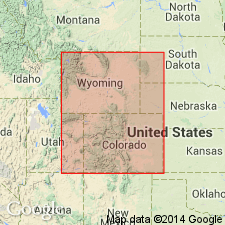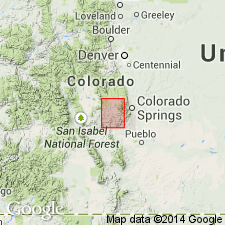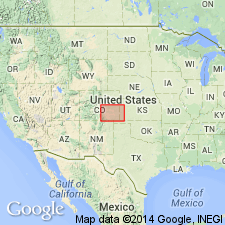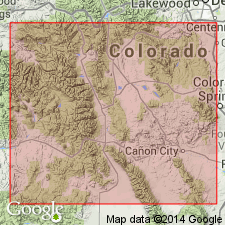
- Usage in publication:
-
- Fremont limestone*
- Modifications:
-
- Original reference
- Dominant lithology:
-
- Limestone
- Sandstone
- Shale
- AAPG geologic province:
-
- Denver basin
Summary:
Pg. 154-167. Fremont limestone. At Canyon City consists of (descending): (1) impure variegated banded limestone with interbedded sandstones and argillaceous beds, 15 to 30 feet; (2) compact, hard light-gray limestone breaking into angular fragments and with a band of purple and gray calcareo-arenaceous shale at base, 45 feet; (3) dark reddish-brown sandstone parting, 10 feet; (4) hard, compact, light-colored limestone, 45 feet; (5) gray siliceous magnesium limestone, somewhat ferruginous in lower part, 170 feet. Total thickness at Canyon City 285 to 300+/- feet. Rests on Harding sandstone and is overlain by Carboniferous limestone. Fossiliferous (protozoans, actinozoans, echinoids, brachiopods, lamellibranchs, gastropods, cephalopods, trilobites). Interpreted as a marine unit deposited in a bay or interior sea.
Type section: Harding's quarry, about 1 mi northwest of the State Penitentiary at Canyon City [Canon City], Fremont Co., CO. [Quarry now (ca. 1966) one of several pits operated under name of Bernite Gannister Quarries.] Named from exposures in Fremont Co., CO.
[GNC remark (ca. 1938, US geologic names lexicon, USGS Bull. 896, p. 779): According to [Edwin] Kirk, the Fremont limestone contains a Richmond (Upper Ordovician) fauna in all but lower 10 feet. Age is considered Middle and Late Ordovician.]
Source: US geologic names lexicons (USGS Bull. 896, p. 779; USGS Bull. 1200, p. 1247, 1671-1672); supplemental information from GNU records (USGS DDS-6; Denver GNULEX).

- Usage in publication:
-
- Fremont limestone*
- Modifications:
-
- Areal extent
- AAPG geologic province:
-
- Denver basin
Summary:
Fremont limestone. Dolomitic gray or pink limestone, of uneven texture and cavernous, forming very rough weathered faces. Thickness about 100 feet in Garden Park; increases to 270 feet near Canyon City, Fremont County, Colorado. Overlies Harding sandstone with apparent conformity. Locally underlies newly named Carboniferous Millsap limestone in Garden Park. Age is considered Silurian. Carries chain coral HALYSITES CATENULATUS, and also invertebrate fauna like that of the upper Trenton of New York.
Source: Publication.

- Usage in publication:
-
- Fremont limestone*
- Modifications:
-
- Overview
- AAPG geologic province:
-
- Denver basin
Summary:
Consists of buff to gray, purple- to pinkish-mottled, finely granular to medium-crystalline dolomite. Is uniform in character. Overlies Harding sandstone. Underlies Williams Canyon Limestone. Recognized at Priest Canyon as far east as Cemetery Park, in Pueblo and Fremont Cos, CO of the Denver basin. Has been called Madison limestone by some. Crops out as far as Beulah where it is 20 ft thick. Is of Middle and Late Ordovician age. Cross sections.
Source: GNU records (USGS DDS-6; Denver GNULEX).

- Usage in publication:
-
- Fremont formation
- Modifications:
-
- Revised
- AAPG geologic province:
-
- Denver basin
- Eagle basin
- Las Vegas-Raton basin
- San Luis basin
- Piceance basin
- South Park basin
Summary:
Revised in that formation divided into a massive dolomite member and the gradationally overlying Priest Canyon member, named in this report, at the top. Unconformably overlies Harding formation (with which it is coextensive) and unconformably underlies Williams Canyon formation. Cross sections, measured sections, isopach map of Priest Canyon Member. Isopach map shows extent Priest Canyon member and another map shows Fremont in Pueblo, El Paso, Teller, and Fremont (Denver basin), Custer (Las Vegas-Raton basin), Saguache (San Luis basin), Lake, Chaffee, and Pitkin (Eagle basin), Gunnison (Piceance basin), and Park (South Park basin) Cos, CO. In a measured section in Priest Canyon (S1/2 NE1/4 sec 13, T18S, R71W) Fremont is 283.5 ft thick. The massive dolomite member is 208.5 ft of massive red-brown, gray to buff, coarse-, medium- to finely crystalline fossiliferous dolomite and the Priest Canyon as a 75 ft thick white-mottled maroon shale (5 ft thick at base) overlain by cream to pink dolomite 70 ft thick. Fossils from 10 to 25 ft above base of massive member (corals, brachiopods, gastropods, cephalopods, echinoderms) and from 5 to 10 ft above base of Priest Canyon (corals, brachiopods, pelecypods, gastropods, cephalopods, trilobites) listed. Of Richmond [or Late] Ordovician age. Regional correlations described.
Source: GNU records (USGS DDS-6; Denver GNULEX).
For more information, please contact Nancy Stamm, Geologic Names Committee Secretary.
Asterisk (*) indicates published by U.S. Geological Survey authors.
"No current usage" (†) implies that a name has been abandoned or has fallen into disuse. Former usage and, if known, replacement name given in parentheses ( ).
Slash (/) indicates name conflicts with nomenclatural guidelines (CSN, 1933; ACSN, 1961, 1970; NACSN, 1983, 2005, 2021). May be explained within brackets ([ ]).

